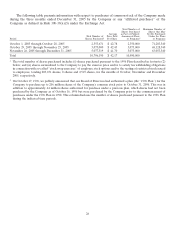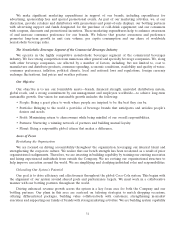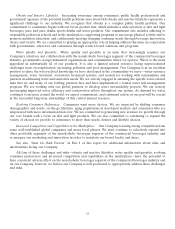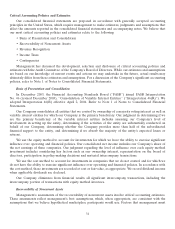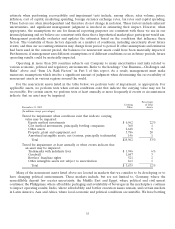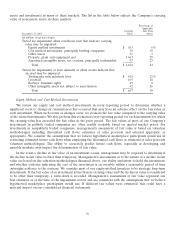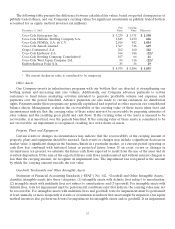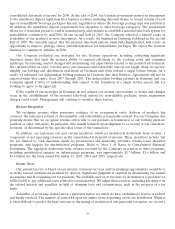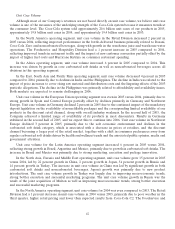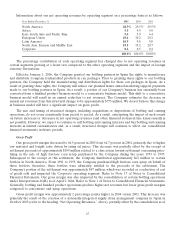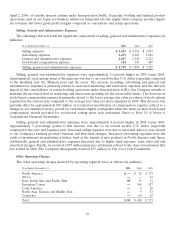Coca Cola 2005 Annual Report Download - page 40
Download and view the complete annual report
Please find page 40 of the 2005 Coca Cola annual report below. You can navigate through the pages in the report by either clicking on the pages listed below, or by using the keyword search tool below to find specific information within the annual report.charge was recorded by one of our equity method investees the Company would record its proportionate share
of such charge.
Our trademarks and other intangible assets determined to have definite lives are amortized over their
useful lives. In accordance with SFAS No. 142, if conditions exist that indicate the carrying value may not be
recoverable, we review such trademarks and other intangible assets with definite lives for impairment to ensure
they are appropriately valued. Such conditions may include an economic downturn in a market or a change in
the assessment of future operations. Trademarks and other intangible assets determined to have indefinite useful
lives are not amortized. We test such trademarks and other intangible assets with indefinite useful lives for
impairment annually, or more frequently if events or circumstances indicate that assets might be impaired.
Goodwill is not amortized. We also perform tests for impairment of goodwill annually, or more frequently if
events or circumstances indicate it might be impaired. All goodwill is assigned to reporting units, which are one
level below our operating segments. Goodwill is assigned to the reporting unit that benefits from the synergies
arising from each business combination. We perform our impairment tests of goodwill at our reporting unit
level. Impairment tests for goodwill include comparing the fair value of the respective reporting unit with its
carrying value, including goodwill. We use a variety of methodologies in conducting these impairment
assessments, including cash flow analyses that, when appropriate, are consistent with the assumptions we believe
hypothetical marketplace participants would use, estimates of sales proceeds and independent appraisals. Where
applicable, we use an appropriate discount rate, based on the Company’s cost of capital rate or location-specific
economic factors.
In 2005, our Company recorded impairment charges of approximately $84 million related to intangible
assets. These intangible assets relate to trademarks for beverages sold in the Philippines. The Philippines is a
component of our East, South Asia and Pacific Rim operating segment. The carrying value of our trademarks in
the Philippines, prior to the recording of the impairment charges in 2005, was approximately $268 million. The
impairment was the result of our revised outlook of the Philippines, which has been unfavorably impacted by
declines in volume and income before income taxes resulting from the continued lack of an affordable package
offering and the continued limited availability of these trademark beverages in the marketplace. We determined
the amount of the impairment by comparing the fair value of the intangible assets to the current carrying value.
Fair values were derived using discounted cash flow analyses with a number of scenarios that were weighted
based on the probability of different outcomes. Because the fair values were less than the carrying values of the
assets, we recorded impairment charges to reduce the carrying values of the assets to fair values. In addition, in
2005, we recorded an impairment charge of approximately $4 million in the line item equity income—net related
to our proportionate share of a write-down of intangible assets recorded by our equity method investee bottler in
the Philippines. Our Company is evaluating and implementing new strategies for the Philippines to address
structural issues with the bottling system and product affordability and availability issues. If the results of these
strategies do not achieve our current expectations, future charges could result related to both our remaining
intangible assets as well as our equity method investment in the Philippines bottling operation. Management will
continue to monitor the Philippines and conduct impairment reviews as required.
In 2004, our Company recorded impairment charges related to intangible assets of approximately
$374 million, primarily related to franchise rights at CCEAG in the European Union operating segment. The
CCEAG impairment was the result of our revised outlook for the German market, which was unfavorably
impacted by volume declines resulting from market shifts related to the deposit law on nonrefillable beverage
packages and the corresponding lack of availability of our products in the discount retail channel. The deposit
law in Germany had led to discount chains creating proprietary nonrefillable packages that could only be
returned to their own stores. We determined the amount of the impairment by comparing the fair value of the
intangible assets to the current carrying value. Fair values were derived using discounted cash flow analyses with
a number of scenarios that were weighted based on the probability of different outcomes. Because the fair value
was less than the carrying value of the assets, we recorded an impairment charge to reduce the carrying value of
the assets to fair value. These impairment charges were recorded in the line item other operating charges in our
38


